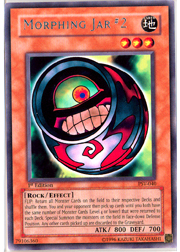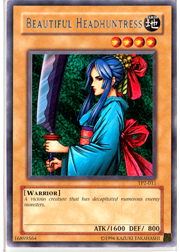Morphing Jar #2 has found a home for itself in many decks. Much like Cyber Jar, this monster is often used as a form of disruption for the game. But unlike Cyber Jar, playing Morphing Jar #2 doesn’t run the risk of adding cards to your opponent’s hand.
Duelists who play with Morphing Jar #2 tend to know how to use it. However, problems come up when duelists use the Jar against opponents who are unfamiliar with the card’s mechanics. This week, we will look at Morphing Jar #2 in detail. By the end of this article, you should have a solid understanding of what the Jar can and cannot do.
Move Along Home
“FLIP: Return all Monster Cards on the field to their respective Decks and shuffle them.”
 When Morphing Jar #2 is flipped up either by a card effect or an attack, all monsters on the field are returned to their owner’s decks when its effect is resolved. When you do this, be sure to keep track of how many monsters each player shuffles into his or her deck, because that information will be important in the next step. I’ll refer to the monsters being returned to the deck as “returned monsters.”
When Morphing Jar #2 is flipped up either by a card effect or an attack, all monsters on the field are returned to their owner’s decks when its effect is resolved. When you do this, be sure to keep track of how many monsters each player shuffles into his or her deck, because that information will be important in the next step. I’ll refer to the monsters being returned to the deck as “returned monsters.”
The Jar’s effect sounds simple enough, but there are a few problems that can quickly develop. Monster tokens can confuse players when facing off against Morphing Jar #2’s effect. It’s helpful to remember that, while on the field, monster tokens are treated as normal monster cards. Morphing Jar #2 will attempt to move monster tokens to the appropriate deck. There’s a hitch, however, because monster tokens can’t be put into a player’s deck. Would you want to try shuffling a marble into your deck? Therefore, when a monster token is moved to a player’s deck, the token is removed from the field and ceases to exist. Because monster tokens can’t be shuffled into the deck, they won’t be counted as monsters you returned to your deck.
Example: Four Sheep and a Lady
 Let’s say I have four sheep tokens and a Beautiful Headhuntress on my side of the field. I activate Swords of Revealing Light, which flips up my opponent’s Morphing Jar #2 and causes its effect to activate. When the effect resolves, my opponent shuffles Morphing Jar #2 into his or her deck, and I shuffle my Beautiful Headhuntress into my deck. All four sheep tokens are removed from the field and cease to exist because they cannot be shuffled into my deck. The final tally is that my opponent and I each have one returned monster.
Let’s say I have four sheep tokens and a Beautiful Headhuntress on my side of the field. I activate Swords of Revealing Light, which flips up my opponent’s Morphing Jar #2 and causes its effect to activate. When the effect resolves, my opponent shuffles Morphing Jar #2 into his or her deck, and I shuffle my Beautiful Headhuntress into my deck. All four sheep tokens are removed from the field and cease to exist because they cannot be shuffled into my deck. The final tally is that my opponent and I each have one returned monster.
Looking at the final tally, I have one returned monster and my opponent has one returned monster.
Fusion monsters have their own problems. Like monster tokens, Fusion monsters can’t be shuffled into a player’s main deck. Fortunately for us, Fusion monsters can return home to the fusion deck. When a Fusion monster would be returned to a player’s deck, it is returned to his or her fusion deck instead. Because they are not shuffled into your main deck, you won’t count them in the number of returned monsters.
Sometimes, your opponent will be in control of one or more of your monsters when Morphing Jar #2’s effect is resolved. It’s important to know that your returned monster tally isn’t based on the number of monsters you have on your side of the field. Only the number of monsters you shuffle into your deck from Morphing Jar #2’s effect matters. Let’s say my opponent controls two of my monsters on the other side of the field, and I have two monsters remaining still on my side of the field. When the Jar resolves, I’ll shuffle a total of four monsters into my deck—the two monsters I had and the two my opponent was controlling.
Here’s one last note about this part of the Jar’s effect. If Morphing Jar #2 is flipped by an attack and it does not survive the attack, the Jar will not return to its owner’s deck when the effect is resolved.
Pick Up a Winner
“You and your opponent then pick up cards until you both have the same number of Monster Cards that were returned to each Deck.”
For example, if you return three monster cards to your deck, you will pick up cards from the top of your deck until you have picked up three monsters. It’s important to note that you don’t draw these cards. These cards are only being picked up because of Morphing Jar #2’s effect—you don’t get to keep them in your hand. It’s a good idea to put your hand off to the side while you take care of Morphing Jar #2’s effect so that the picked-up cards don’t accidentally find their way into your hand. Mixing picked-up cards with your hand can be a very bad mistake to make in tournament play.
It’s also a good idea to reveal to your opponent the cards you are picking up as you resolve the Jar’s effect. The picked-up cards aren’t a mystery, because they aren’t going to be added to your hand. Plus, you’ll need to show your opponent the cards that will be special summoned during the next step of the Jar’s effect.
If a player runs out of cards in his or her deck while resolving Morphing Jar #2’s effect, he or she doesn’t immediately lose the duel. This is because you’re picking up cards, not drawing them. However, the player in question is going to be in trouble when his or her next turn starts.
Summons and Discards
“Special Summon the Level 4 or lower monsters to the field in face-down Defense Position. The rest of the cards picked up are discarded to the Graveyard.”
It’s time for you and your opponent to look over the cards you each picked up from your decks. The monsters that are level 4 or lower that were picked up are special summoned to the field in face-down defense position. The remaining cards are then discarded to the graveyard. Therefore, picking up high-level monsters like Jinzo and Airknight Parshath ends up hurting your defenses, because you’re not replacing a monster that was returned to your deck. In addition, you’ll lose any spell or trap cards that you picked up.
Another thing to watch out for are monsters with special summoning requirements or restrictions. For example, lower-level Spirit monsters like Yata-Garasu and Tsukuyomi can’t be special summoned, while Gigantes and Fenrir have special summoning requirements that prevent them from being special summoned in this case. In addition, all lower-level Ritual monsters need to be special summoned with their respective ritual spell cards. Because of these restrictions, they can’t be special summoned by Morphing Jar #2’s effect. They are instead lumped in with “the rest of the cards picked up,” and will be discarded.
You should know that the cards you discard for this effect are not treated the same way as cards you discard from your hand. The difference is important when you’re talking about card effects that activate when a card is discarded from your hand to the graveyard, like Magical Thorn.
A Bit More Chaos
 Will I get to use the effect of Despair from the Dark if I pick it up because of my opponent’s Morphing Jar #2 ?
Will I get to use the effect of Despair from the Dark if I pick it up because of my opponent’s Morphing Jar #2 ?
You will, but only if your opponent activated the Jar’s effect. Cards discarded from the effect of Morphing Jar #2 are not considered to have been in the hand. Due to this, they are treated as having been sent directly from the deck to the graveyard. Despair from the Dark’s effect activates if the monster is among the cards that are sent from the deck to the graveyard because of the Jar’s effect.
What if I pick up Rare Metal Dragon? Can I still set it, or not because of its effect?”
Keep in mind that, even though the monsters are placed face down, they are actually being special summoned by the effect of Morphing Jar #2. Therefore, in this situation, you can special summon Rare Metal Dragon in face-down defense position if you get it from Morphing Jar #2’s effect.
I hope that this article has helped clear up how to use Morphing Jar #2’s effect. Be sure to come back next week, when we’ll be talking about the king of Dragons!